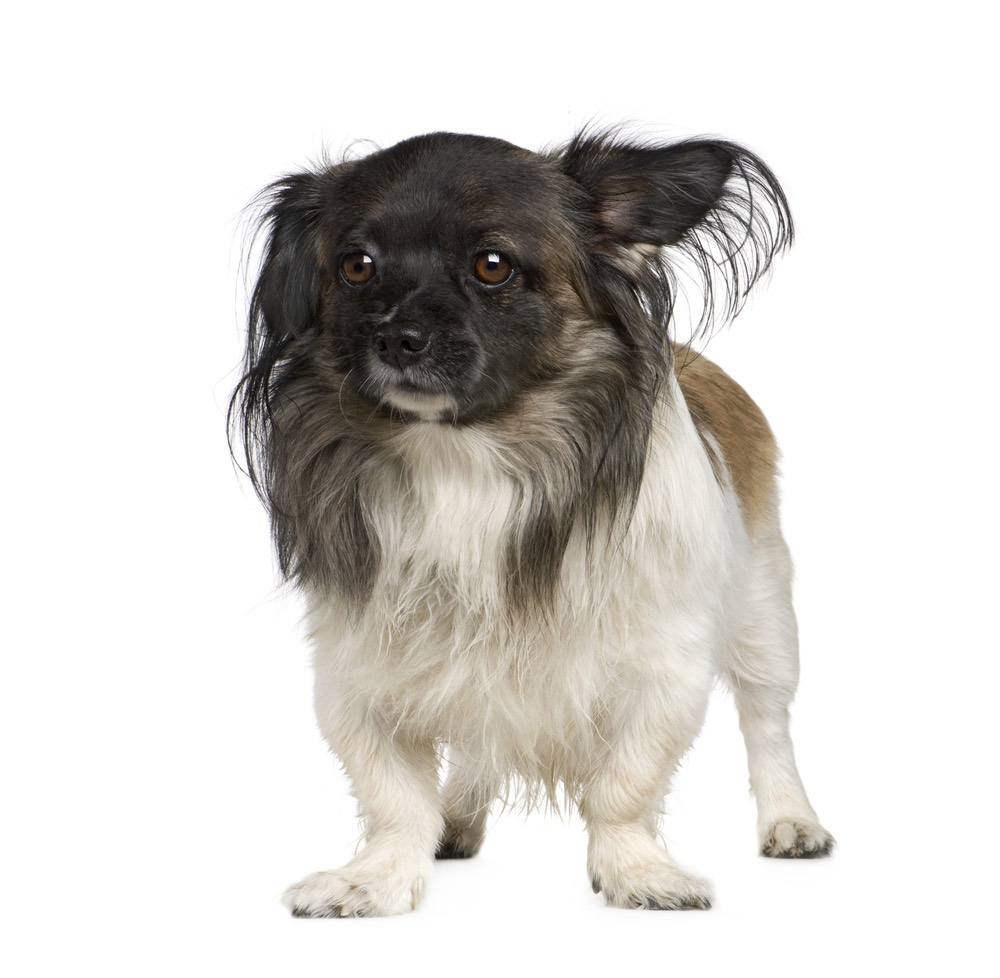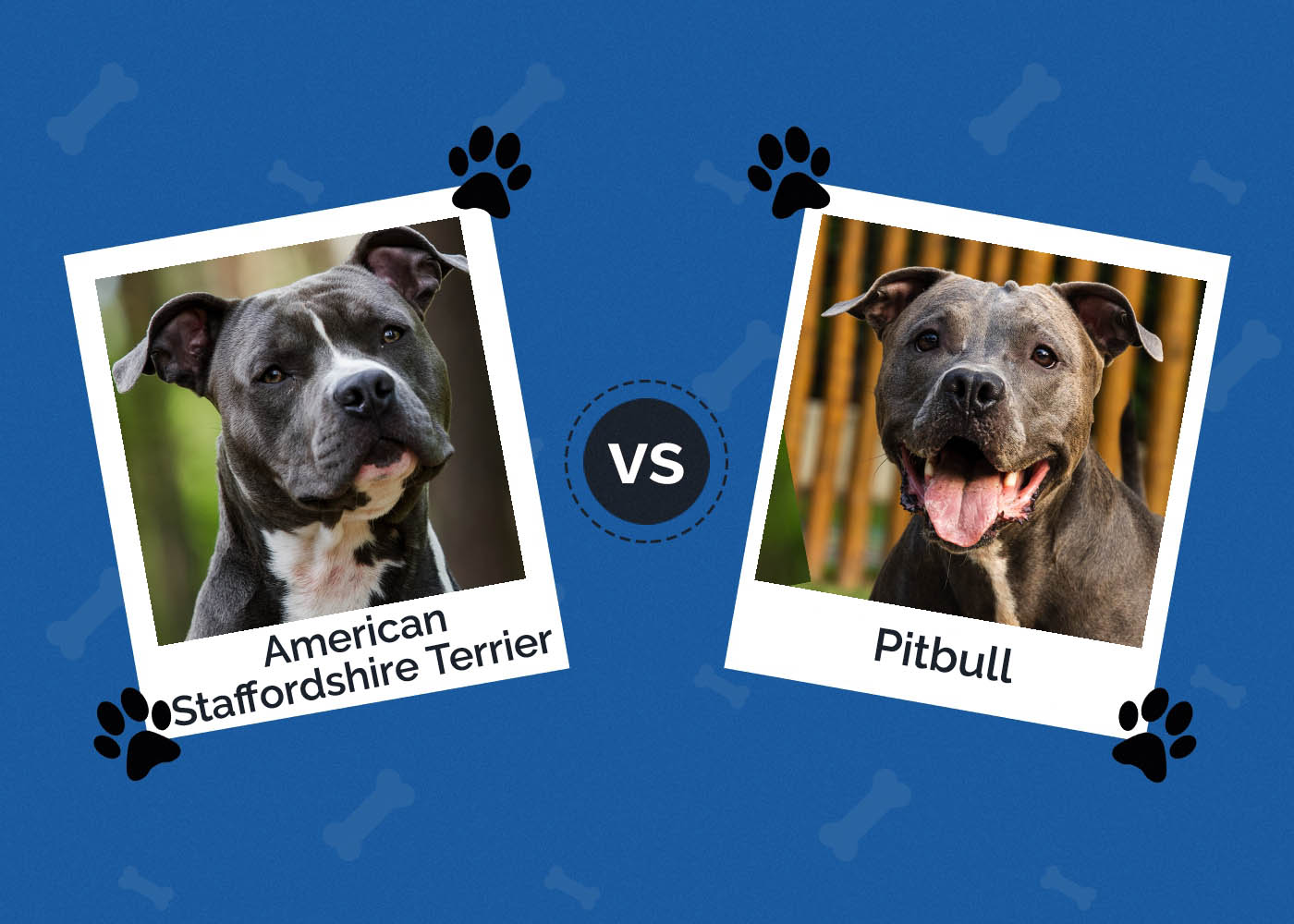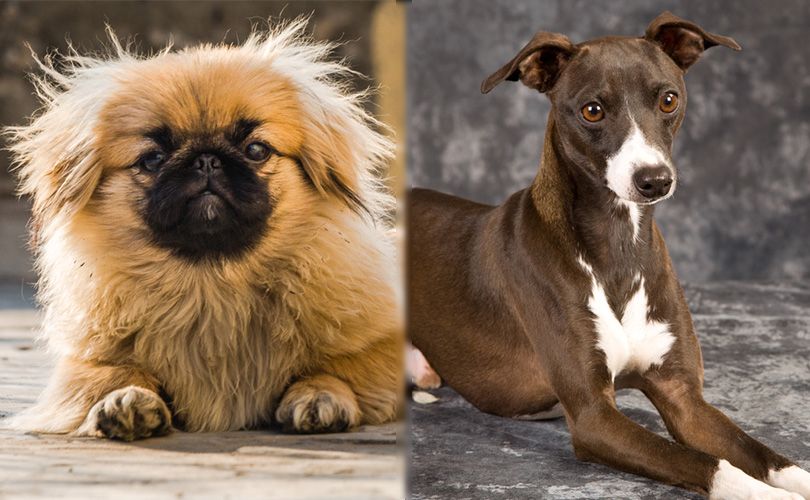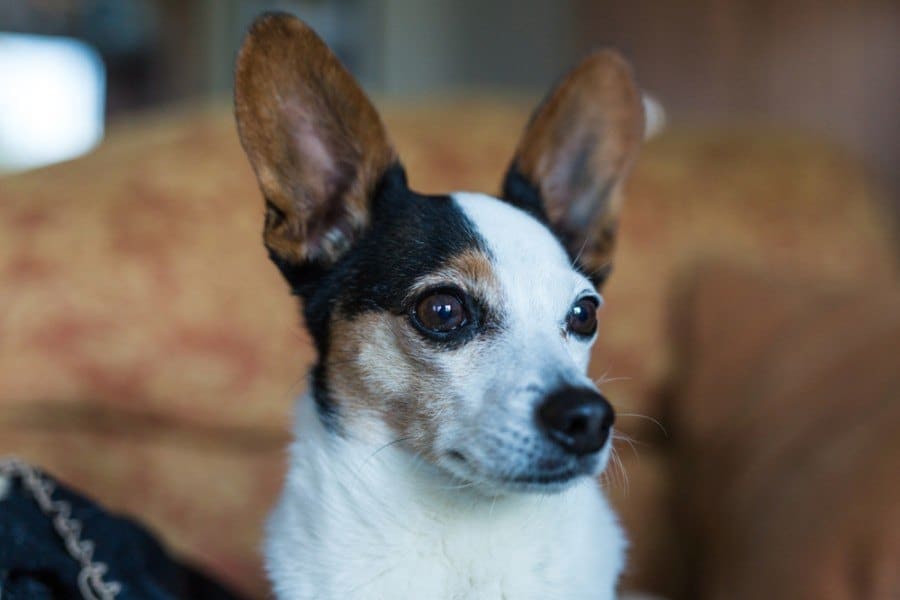Peke-A-Pap (Papillon & Pekingese Mix)

Updated on

Height:
6-10 inches
Weight:
6-9 pounds
Lifespan:
12 to 16 years
Colors:
Black, brown and white
Suitable for:
Families, singles, apartments, urban living, seniors
Temperament:
Friendly, busy, active, affectionate, loving, lively
The Peke-A-Pap is a hybrid breed, bringing together two of the world’s smallest dogs: the stocky Pekingese and the regal Papillon. The result is a dog that is tiny yet has just as much personality and zest for life. They are the quintessential lapdogs and will love nothing more than chilling with their owners. In order to truly understand this hybrid breed, it helps to take a quick look at the background of each parent breed.
The Pekingese breed originated in China over 2,000 years ago and for centuries, were the loyal companions of Chinese Imperials. They are also known as the “Lion Dog,” partly due to the mop of long hair and partly due to their courageous, fearless temperament. Indeed, they are so brave at times, it borders on foolishness, resulting in picking fights that they cannot possibly win. These dogs will fight to the death to defend their family.
The Papillon is most characterized by its large, upright ears that look like wings, and they were named for this unique characteristic (Papillon is French for “butterfly”). They have a recorded history going back more than 500 years, and their main claim to fame is being the dog of choice for Marie Antoinette.
If the Peke-A-Pap sounds like the right choice of dog for you, read on below for an in-depth look at this unique hybrid breed.
 Peke-A-Pap Puppies — Before You Buy…
Peke-A-Pap Puppies — Before You Buy…
The Peke-A-Pap is a lapdog through and through, and the ideal choice if you are looking for a buddy to keep you company without needing a great deal of exercise. Rest assured that these dogs will likely be your shadow and content to be at your side, no matter what you may be doing. They are highly intelligent, coming from two breeds with high intellect, and this will usually make them easy to train. They do have an independent side that can result in stubbornness at times, though, but their desire to please their owner will often overrule this trait.
They usually have the same “butterfly” ears of their Papillon heritage, with the small, flat face and nose of the Pekingese. They are most commonly a mixture of black, white, and brown colors, with long, straight, and smooth coats that beg to be groomed. One charming and somewhat irresistible characteristic of these dogs is their round, alert, and expressive eyes that seem to hypnotize you into doing their bidding. A word of warning when going to view one of these puppies: you are highly likely to bring one home.
What’s the Price of Peke-A-Pap Puppies?
Peke-A-Pap puppies usually range from around $800 up to $1,500, depending on a few different factors. The pedigree, history, and lineage of the parent breed play a big role in price, and first-generation puppies from well-established lineages will fetch higher prices. The price will also depend on availability in your area and on the particular breeder you choose.
Temperament & Intelligence of the Peke-A-Pap
Peke-A-Paps seem to love the sound of their voice and will bark incessantly if left to their own devices. You’d think this would make them a good guard dog, but you soon realize that a leaf falling off a tree is enough to get a Peke-A-Pap going. Although they are primarily lapdogs and companion animals, they still love a good play session and will thoroughly enjoy their daily walk and family activities.
These pooches are clever, and they use this intellect to get their own way. They love to please their owners, but at the same time, they have a stubborn streak that can make them a challenge to train. They are prone to barking, making them great watchdogs, but this barking can quickly get out of hand when left unchecked. They need early socialization, exercise, and firm training.
That being said, they are easy to train, making them ideal for first-time owners and experienced owners alike.
Are These Dogs Good for Families?
Peke-A-Paps make great family dogs in general, with their friendly, playful nature and small stature. They may present a challenge for young children like toddlers, as they are known to snap and nip when handled roughly. This can be managed with good training, but it may be good practice to keep them away from young children if possible. They love nothing more than to be around their owners, so they will suffer from separation anxiety if left alone for extended periods.
Does This Breed Get Along With Other Pets?
The Peke-A-Pap is a mostly gentle breed that doesn’t have a strong prey drive or aggressive streak and will get along great with other pets. The only problem you may run into is the nature of these dogs to become highly attached to their owners, and they may snap or show aggression toward other pets if they feel that connection is being threatened in any way.
 Things to Know When Owning a Peke-A-Pap
Things to Know When Owning a Peke-A-Pap
Food & Diet Requirements
Peke-A-Paps are small dogs with small appetites and only require around 1 cup of high-quality kibble a day. They can get overweight easily, so try and avoid giving them treats and table scraps and aim for the best quality kibble that you can afford. Some low-quality kibbles have plenty of filler ingredients, like wheat and corn, which can cause a host of health issues and quickly lead to an overweight pooch. The empty calories in these foods will mean that your pooch will need to eat more to get satisfied, and thus, they will gain weight.
We recommend substituting this kibble occasionally with lean meats to give your pooch an extra boost of quality protein.
Exercise
Peke-A-Paps require regular exercise to reduce or prevent any bad behavior like barking or digging, which these little pooches can be prone to doing. These dogs love to lounge on their owner’s lap and don’t need tons of intensive exercise to stay happy. But like all dogs, they do require daily exercise, and around 30-60 minutes a day is plenty. They are small dogs, and exercise sessions are best kept short, so two 30-minute sessions a day will sufficiently exercise them without getting them overly tired out.
Peke-A-Paps love to play, so games of fetch or frisbee in the yard are great mental and physical stimulation for them, and it will create a strong bond between you and your canine. While these dogs are well adjusted to apartment living, they love to play outdoors too. Just don’t leave them alone outside for extended periods, as they will not be happy!
https://www.instagram.com/p/CNnNtIEBZA1/?utm_source=ig_web_copy_link
Training
Peke-A-Paps are eager to please and will likely love the routine associated with training. This also makes them easy to train and ideal for novice dog owners. They do have a stubborn streak at times, probably due to their pampered royal heritage, and this can present a challenge when training.
An ideal way to mitigate this stubborn streak is to start training the day that you bring home your puppy. This begins with basic commands, like sitting before eating and introducing them to other animals early on. Early socialization with well-behaved dogs will go a long way in teaching your pooch good behavior.
We also recommend making training sessions as fun and as short as possible. A fun training session will make your dog excited when it’s time for the next session, and short sessions will prevent them from getting bored and distracted.
Grooming ✂️
The Peke-A-Pap has a thick and long double coat that will require daily brushing to prevent knotting and matting. They may also need the occasional trim, especially around the eyes, ears, and paws. Bear in mind that these dogs do not do well in hot weather and will overheat quickly out in the blazing sun. They will not need a bath unless they get muddy, and even then, we recommend using only water or special dog shampoo. Using soaps too often can damage their skin and coat, causing rashes or dry, flakey skin.
They will need to get their teeth brushed regularly, at least a few times a week to prevent any dental issues. These dogs have very small mouths, which can often be afflicted with varying degrees of supernumerary teeth, in which food can quickly become trapped and cause tooth decay. Trim their nails at least once a month to avoid any breakages or infections, and keep their ears dry and perform regular checks for redness or infection.
Health and Conditions ✂️
Peke-A-Paps benefit from hybrid vigor, a crossbred trait that allows them to be healthier than their parental counterparts. There are, however, a few health concerns to take into consideration.
Collapsing trachea is common in most small dogs but can be usually be treated with medication. Supernumerary teeth are also fairly common in small dogs and can cause a host of dental issues.
Pekingese commonly suffer from brachycephalic airway syndrome, which causes difficulty breathing, and this may be passed down to Peke-A-Paps. Papillons are prone to deafness and other ear issues and hypothyroidism in some cases.
Obesity, skin allergies, and bloat are also fairly common issues, but these are usually diet-related and easy to avoid.
- Allergies
- Bloat
- Obesity
- Eye disease
- Dental disease
- Supernumerary teeth
- Collapsing tracheae
- Cancer
- Patella luxation
- Collapsing tracheae
- Brachycephalic airway syndrome
- Hypothyroidism
Male vs Female
If the Peke-A-Pap sounds like the breed for you, the final question to consider is: should you get a male or female? Remember, though, that your dog’s upbringing will have far more of an effect on their personality than their gender, and neutering males or spaying females will further iron out any differences. After all, all dogs are individuals, and the main differences between male and female Peke-A-Paps are anecdotal and broad generalizations. However, these generalizations are of some use when considering which gender to bring home.
Male Peke-A-Paps are generally bigger, taller, and stronger than females, albeit not by much. The males may also exhibit more aggression, possessiveness, and independence than females, though neutering them will mostly mitigate this. Males tend to be slightly more difficult to train than females because they mature slower and can be more stubborn and independently minded.
3 Little-Known Facts About Peke-A-Paps
1. They have ancient origins.
Both the Papillon and Pekingese are ancient breeds. Evidence of the Papillon stretches as far back as the early 1500s when they were immortalized in ancient paintings. The Papillon is one of the oldest Toy Spaniel breeds, and they get their name from the French word for “butterfly.” This name is due to their characteristic upright ears. Their ears, however, are not always erect, and there is another variety of Papillon known as the Phalene (French for “moth”), which has dropped ears.
The Pekingese is also an ancient breed, being kept as companions for Chinese Imperials. There is evidence of these dogs stretching as far back as AD 700 to the Han dynasty, and some suggest that they were bred to resemble Chinese “foo dogs.”
You may not think it by looking at them, but Pekingese is one of the closest modern relations to wolves. They may not resemble wolves physically or biochemically, but they are among the least changed dog breeds at the DNA level. Early breeders set out to breed a dog resembling a lion, not a wolf. The Han dynasty held lions in high esteem, and the Asiatic lion was long extinct. All they had to guide them were the stylized ancient carvings of the “foo dog,” or “guardian lions,” which ultimately resembled a dog more than a lion.
3. The Pekingese was originally for royalty only.
During the rule of the Tang Dynasty, from 618-907, it was forbidden for anyone outside the Imperial palace to own, sell, or breed a Pekingese. These dogs were kept exclusively for royalty, and if any citizen outside to palace met a Pekingese in the street, they were instructed to bow in reverence.
The Papillon was also revered by royalty, if not exclusively. They were popular with French royalty and subsequently, could be sold for substantial amounts of money.

 Final Thoughts
Final Thoughts
Peke-A-Paps are the quintessential lapdog, and if you are looking for a buddy who is happy to chill with you on the sofa most of the time, they are a great choice. They also don’t need a ton of exercise but will still enjoy their daily outdoor activities just the same. They are playful, friendly, and intelligent pooches that love to be around people, and their eagerness to please their owners makes them easy to train. Bear in mind, though, that they do have a stubborn streak that they may choose to exercise when they so desire. While these dogs are small in stature and don’t require a big backyard, making them ideal for apartment living, they tend to bark at anything that moves, so you may want to warn your neighbors.
The Peke-A-Pap is an ideal companion dog no matter where you live, and you can rest assured that they will soon become your new shadow.
Featured Image Credit to Eric Isselee, Shutterstock
 Peke-A-Pap Puppies — Before You Buy…
Peke-A-Pap Puppies — Before You Buy… Things to Know When Owning a Peke-A-Pap
Things to Know When Owning a Peke-A-Pap
 Final Thoughts
Final Thoughts








